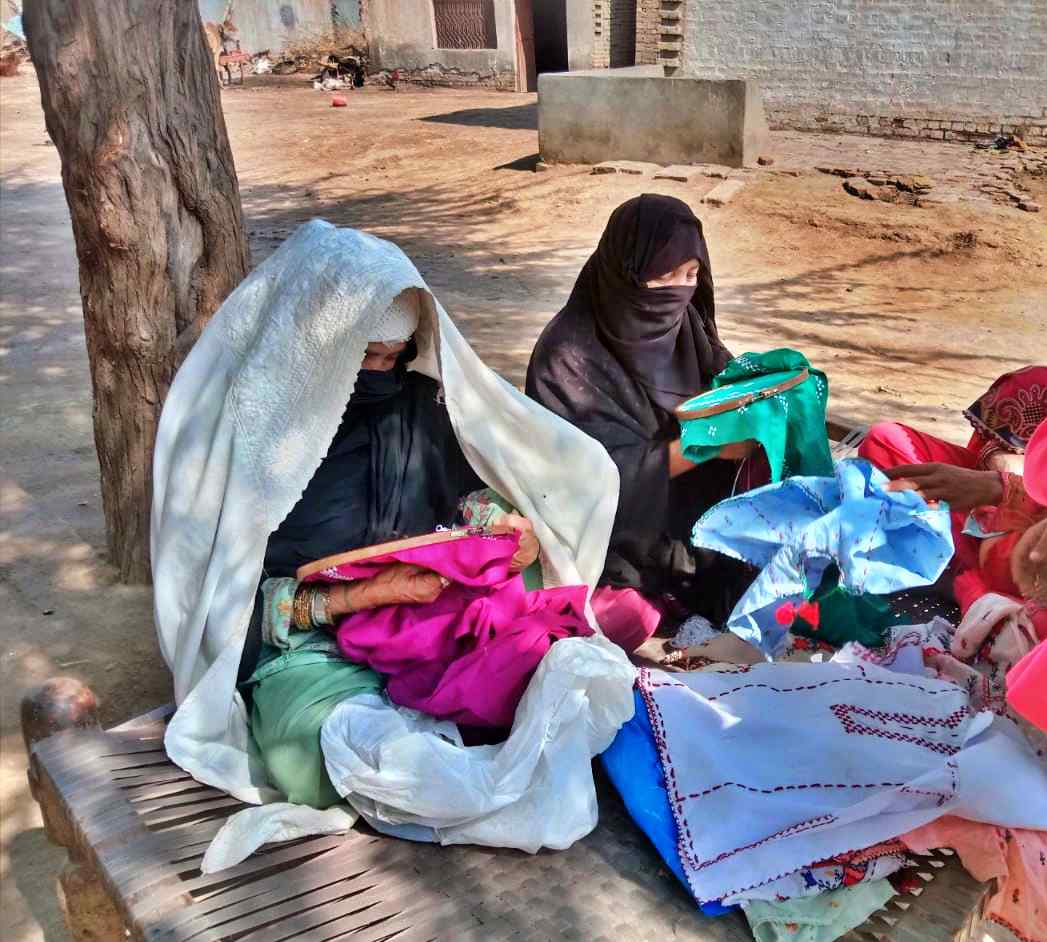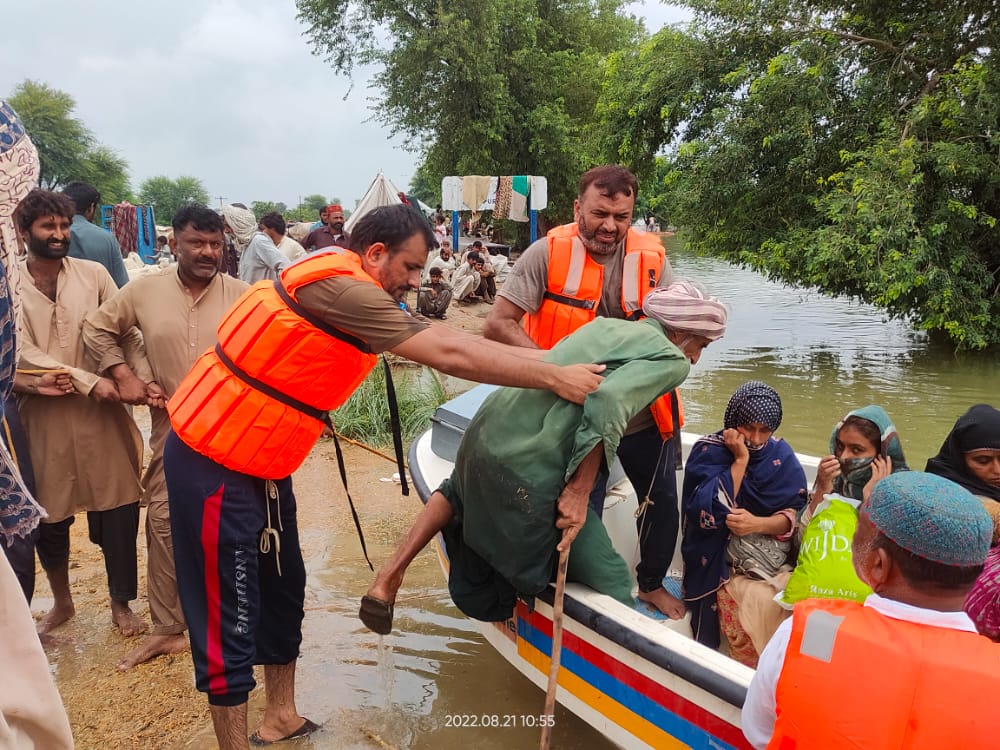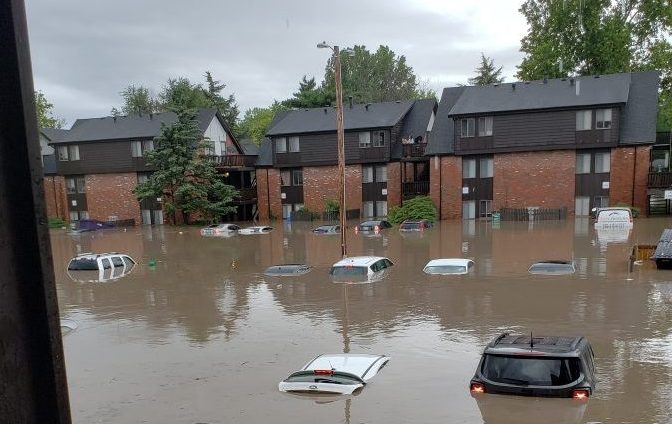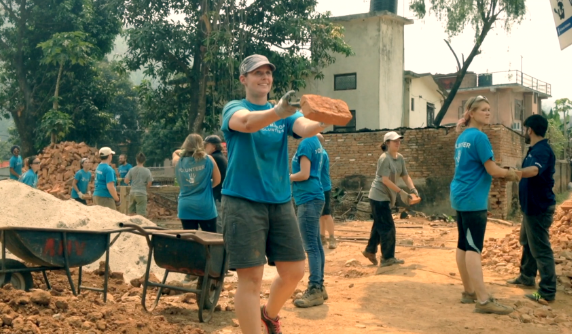
Last updated:
2022 Pakistan Floods

Overview
Pakistan’s 2022 monsoon season produced significant rainfall, devastating floods and landslides, affecting millions of people.
The floods affected all four of the country’s provinces and approximately 15% of its population. In 2023, recovery was tedious and many affected people continued to struggle.
Pakistan has some of the highest disaster risk levels in the world. In addition to flooding, the country is exposed to earthquakes and risk of conflict. In addition, Pakistan’s disaster risk is driven by its social vulnerability, especially its high rates of poverty.
The 2023 monsoon season hampered recovery from the 2022 floods and brought additional hardship for affected people. Between July 25-30, 2023, Pakistan’s southwestern provinces faced devastation due to heavy monsoon rains and flash floods. As of Aug. 5, 2023, the disaster resulted in the deaths of 196 people and injured 283 more across seven provinces.
Human Rights Watch said the floods show the need for climate action. Despite being responsible for less than 1% of global greenhouse gas emissions, Pakistan is among the countries worst affected by extreme weather events due to climate change. A study from NASA scientists published in the journal Nature Water found that increasingly frequent, widespread and intense droughts and floods were linked more strongly to higher global temperatures than to naturally changing weather patterns.
As of Sept. 6, 2023, donors had funded only 68.2% of the $816 million requested in the revised Pakistan Floods Response Plan.
(Photo: Rescue activities in flood-affected areas in South Punjab, Pakistan. Credit: Punjab Emergency Services via Twitter)
The disaster was likely the result of a combination of factors, including the socioeconomic conditions of affected people, steep slopes in some regions, unexpected failing of embankments and climate variation. Despite investing in disaster risk management following the 2010 floods, Pakistan’s systems and institutions were not adequately equipped for the unprecedented scale of this climate-induced disaster.
One study found that the 2010 flood event was made more likely by global heating, driving fiercer rains. According to another 2021 study, global heating is making the south Asian monsoon more intense and erratic. The Global Climate Risk Index ranks Pakistan eighth most at risk in the world. Since 1959, Pakistan has been responsible for only 0.4% of the world’s historic emissions blamed for climate change, whereas the U.S. is responsible for 21.5%. A group of international climate scientists in Pakistan, Europe and the U.S. said climate change made the heavy rainfall in 2022 more likely.
Adding a layer of complexity to the disaster was the country’s bleak economic situation. Pakistan faced its worst economic crisis since independence from Britain in 1947. The inflation rate in Pakistan increased by 3.46%, reaching 28.3% in July 2023.
The Jan. 30 suicide bombing attack on a mosque in Peshawar, the capital of Khyber Pakhtunkhwa province, one of the flood-affected provinces, poses another challenge for Pakistan as it begins implementing its flood recovery and reconstruction plans. The Pakistani Taliban have a strong presence in Khyber Pakhtunkhwa, and Peshawar has been the site of regular militant attacks.
Latest Updates

CDP announces recovery and resilience grants for Pakistan floods
Key facts
- Floods affected at least 33 million people and killed at least 1,739 from the beginning of monsoon season in mid-June 2022 to Nov. 18, 2022.
- 20.6 million people required humanitarian assistance.
- According to the post-disaster needs assessment, the flooding caused $14.9 billion in damages and $15.2 billion in economic losses. Estimated needs for rehabilitation and reconstruction in a resilient way are at least $16.3 billion.
- The UN’s development agency, UNDP, said an additional nine million people were at-risk of being pushed into poverty on top of the 33 million affected by the devastating floods.
- Almost 10.5 million people in Pakistan experienced high levels of acute food insecurity between April to October 2023.
- More than 1.2 million livestock were killed during the 2022 monsoons, with severe repercussions on the livelihoods of affected households and the supply of animal products, including milk and meat.
- According to officials, the floods affected nearly 15% of Pakistan’s rice crop and 40% of its cotton crop.
- The floods displaced at least 7.9 million people. In 2023, many displaced people returned to their places of origin, but they returned to challenging circumstances.
- More than 2.1 million homes were damaged or destroyed by the floods in 2022.
- As of March 31, 2023, humanitarian partners had provided assistance to an estimated 7.51 million people.
- As of Aug. 25, 2022, Pakistan received nearly 15 inches (375 millimeters) of rainfall, almost three times higher than the national 30-year average of 5 inches (130 millimeters). Balochistan province received five times its average 30-year rainfall.
Education
According to the Pakistan Education Sector Working Group, the floods affected 2.2 million children and damaged a total of 34,204 schools in 126 districts.
Pakistan has a long history of major disasters disrupting education for children. Work to cleanup and restore educational facilities damaged by the flooding will take time and temporary learning centers have been used to continue children’s education as recovery continues.
IOM conducted a Community Needs Identification (CNI) in Balochistan and Khyber Pakhtunkhwa provinces between January and March 2023. The CNI found that distance, cost of education and lack of learning supplies as the main issues to access education services for displaced children.
Nearly one year on from the floods, school reconstruction was insufficient. Considering the scale of damaged and destroyed schools, this is understandable, however, the implications for children’s education are severe.
Livelihoods and agriculture
According to the Food and Agriculture Organization of the United Nations (FAO), some 9.4 million acres of crop area in Pakistan were potentially inundated in August 2022, including 4.8 million acres in Sindh, 2.7 million acres in Punjab, 1.2 million acres in Balochistan and 714,000 acres in Khyber Pakhtunkhwa. At least 1.2 million livestock were killed, with severe repercussions on the livelihoods of affected households and the supply of animal products, including milk and meat.
According to officials, the floods affected nearly 15% of Pakistan’s rice crop and 40% of its cotton crop. Floodwaters wiped out the personal grain stores that many farming families rely on for food yearlong.
Sindh province accounts for nearly one-quarter of the country’s agricultural output, so the damage to crops there and reduced harvests were expected to have implications for food security in Pakistan.
The post-disaster needs assessment released in October 2022, said poverty could potentially increase by 5.9 percentage points, meaning that an additional 1.9 million households are at risk of being pushed into poverty. In addition to impacts being felt by farmers and herders, Pakistan’s fishers are also struggled.
In early January 2023, UNDP said it estimated that an additional nine million people risk being pushed into poverty.
Food insecurity
A critical concern in flood-affected areas was the nutrition crisis. A rapid survey by the UN’s Children’s Fund in 15 flood-affected districts released in May 2023 revealed that “one-third of children aged 6-23 months suffer from moderate acute malnutrition, and 14% suffer from severe acute malnutrition, a life threatening form of malnutrition.”
FAO and WFP said in their acute food security outlook for June-November 2023, “Acute food insecurity is likely to further deteriorate over the coming months, if the economic and political crisis further worsens, compounding the effects of the 2022 flooding.”
The rise in inflation had an impact on the ability of families to secure food. According to WFP’s market monitoring in March 2023, “Headline inflation based on the Consumer Price Index (CPI) is the highest in 49 years (since 1974), representing an increase of 31.55% in February 2023 compared to February 2022. It should be noted that inflation rates in neighbouring countries stand at 3.6% (Afghanistan), 6.4% (India), and 8.8% (Bangladesh).”
The WFP report also said food prices continued to increase since February 2022 for the 12th consecutive month. The inflation rate in Pakistan increased by 3.46%, reaching 28.3% in July 2023.
Public infrastructure
Worsening the humanitarian situation was the significant damage to roads, bridges and telecommunications across the country. The floods damaged more than 8,000 miles (13,000 kilometers) of roads and 410 bridges, hampering people’s ability to seek safety and reach markets. Sindh province was the most affected, with 64% of the total road damage and 40% of the bridge damage nationwide. The floods also caused “unprecedented damage” to Pakistan’s rail network.
Internet outages were reported, with the Pakistan Telecommunications Authority attributing the cuts to faults in the fiberoptic network resulting from the floods. Flash floods and landslides were compounded by the inability of existing infrastructure to cope with the extraordinary amount of water.
Water infrastructure suffered significant damage, and the flood-affected health system was impaired in addressing and mitigating the risk of a major public health crisis. Damaged health infrastructure and inadequate water and sanitation compounded the risk of measles and rubella, along with water-borne, skin, and acute respiratory illnesses.
Prior to the floods, the country’s drinking water supply system covered 92% of the population. However, only 36% of the water was considered safe for consumption. The floods damaged most of the water systems in affected areas, leaving more than 5.4 million people to rely on contaminated water from ponds and wells.
Shelter
The floods caused total or partial damage to 2.1 million homes, a staggering statistic.
An example of the results of the enormous needs combined with very limited resources was that the Shelter Sector was forced to reduce shelter assistance to include just one tarpaulin per household, halving the normal international standards for humanitarian response.
IOM conducted a CNI in Balochistan and Khyber Pakhtunkhwa provinces between January and March 2023. The CNI found that 60% of temporarily displaced households were living in temporary structures (i.e. tents or emergency shelters).
Health
Health officials warned of large-scale disease outbreaks following the flooding. They were very concerned about the potential spread of waterborne diseases, which will further strained health facilities.
According to UNICEF in March 2023, “more than 10 million people, including children, living in flood-affected areas remain deprived of safe drinking water, leaving families with no alternative but to drink and use potentially disease-ridden water.”
According to the revised Pakistan 2022 Floods Response Plan, “Damage to drinking supply systems and more than 1,460 public health facilities and their contents have reduced access to safe and clean water and inhibited the provision of health services at a time of increased need. Women are disproportionately affected, as they typically bear the burden of tasks such as collecting water for daily household needs and caring for the sick.”
Pakistan had been making steady progress against malaria. However, the floods hit districts that had the most difficult malaria situation already.
In early February 2023, malaria and cholera were significant public health concerns. In their Feb. 6, 2023 Situation Report, UNOCHA said high malaria positivity rates had been reported at least in 12 flood-affected districts of Sindh and Balochistan. Also, “sporadic cases of cholera are being reported with the potential to spread given the poor access to safe water and sanitation.”
The floods had a significant impact on health, particularly for children.
As is often the case in disasters, the floods exacerbated underlying vulnerabilities that existed prior to the flooding. Share on X
According to WHO, “Pakistan is among the top 10 countries in the world with a large pool of unvaccinated or undervaccinated children and is home to more than 600,000 children who have not received a single vaccine dose. The recent floods have compounded the problem, further reducing access to routine immunization services, especially in flood-affected districts.”
IOM conducted a CNI in Balochistan and Khyber Pakhtunkhwa provinces between January and March 2023. The CNI found that suspected/confirmed malaria (39%) and respiratory infection (20%) were reported as the primary health concerns in the assessed villages.
Also worrying was that, at the height of the floods, almost 650,000 women in flood-affected areas needed maternity services, but damage to health facilities, limited medical supplies and challenges reaching functioning facilities prevented some women from getting the care they needed. Experts feared an increase in infant mortality or health complications for mothers or children in a country that already has one of the highest maternal mortality rates in Asia.
According to UNOCHA in early February 2023, “The 5.71 million women and girls in flood-affected areas continue to be at a high risk of gender-based violence (GBV), compounding pre-existing gender inequality and vulnerabilities, lack of availability and access to lifesaving GBV services. With limited and/or no access to services, women and girls are at heightened risk of resorting to negative coping mechanisms.”
The government was concerned about the spread of the wild poliovirus as millions of people were displaced due to the flooding. On Sept. 28, 2022, partners of the Global Polio Eradication Initiative and donors met in Islamabad to assess needs and discuss a path forward. A three-day-long campaign was held from Jan. 16-18, 2023 with the aim to immunize more than 44.2 million children under the age of five against the poliovirus. On March 17, 2023, the Pakistan National Polio Laboratory confirmed a three-year-old child was paralyzed by polio.
Education support
The Education Sector Working Group has prioritized the following activities for the period between September 2022 and May 2023 to address the immediate education needs in flood-affected districts:
- Establishment of temporary learning centers or alternate learning modalities in flood-affected districts.
- Distribution of teaching and learning materials as well as school and dignity kits
- Dewatering, cleaning and disinfection of schools to facilitate the resumption of educational activities.
- Minor repairs to damaged schools.
- Conduct welcome back to school activities.
- School feeding.
- Establishment of prefabricated structures in locations with fully damaged schools.
- Training of teachers on psychosocial support, multi-grade teaching and teaching in emergencies.
- Training and mobilization of School Management Committee members.
- Winterization kits.
The primary challenge in meeting education needs is resource constraints. A secondary challenge is the use of schools for non-education purposes, including hosting displaced people.
Cash assistance
Millions of people lost everything in the flooding and landslides. Direct cash assistance can allow families to purchase items and services locally that address their multiple needs. It gives each family flexibility and choice, ensuring that support is tailored, relevant and timely. Cash assistance can also help move families faster toward rebuilding their lives.
The extent of damage to houses and the most recently completed rapid needs assessment results show that most of the affected population needed rental cash assistance. The provision of cash-for-work to remove debris and repair homes is another recovery strategy.
Cash assistance should be prioritized for refugee and other marginalized households. An initiative launched by UNHCR, the UN Refugee Agency, on Feb. 2, 2023, and in collaboration with the government of Pakistan, was a one-time cash assistance scheme for around 1.3 million Afghan refugees in Pakistan affected by the devastating 2022 floods. Notably, the assistance reached refugees who are not eligible to access social safety nets available to Pakistani citizens.
According to a rapid needs assessment of older people by HelpAge International, almost three-quarters of older people reported that they could utilize cash assistance if it was provided. HelpAge International recommends that cash transfers be provided to older people when possible and safe to use because recipients can choose the items they need most.
The revised Pakistan 2022 Floods Response Plan complemented the Pakistan government’s broader response activities, such as the individual cash assistance provided through the Benazir Income Support Programme (BISP), and focused on supporting the most vulnerable communities with cash transfers. As of Oct. 25, 2022, the BISP had reached over 2.7 million flood-affected households with cash assistance of $113 (PKR 25,000) per household.
As of Feb. 24, 2023, WFP had provided $19.6 million in cash-based transfers. However, starting in mid-February 2023, the UN agency had to scale down its assistance due to resource constraints, even as significant humanitarian needs persisted.
Food security and agriculture support
Of the $816 million in funding requirements outlined in the revised Pakistan 2022 Floods Response Plan, $269.4 million was for the food security and agriculture sector, demonstrating the significant need. The Floods Response Plan identified 14.6 million people in need of food security and agriculture assistance and targeted 4 million. Targeted food assistance for the most at-risk populations was needed, along with cash assistance to help with the restoration of livelihood opportunities.
The protection of remaining livestock through the provision of feed and vaccinations is critical. Damages to vital infrastructure and other restrictions affected humanitarian’s ability to distribute food and other supplies, demonstrating the value of cash assistance. Ongoing support is also required for scaling up food assistance in districts with needs but not declared worst-hit districts.
For many households, livestock often serves as collateral for loans, including to finance the purchase of seeds for sowing crops. The loss of livestock and widespread crop damage thus presented significant economic and food security repercussions.
Protection
Marginalized people, including refugees, people with disabilities, the elderly, transgender people, women and unaccompanied children, experience greater difficulties in accessing essential aid and services and are vulnerable to abuse, violence and exploitation at points of assistance.
According to CARE Pakistan Country Director Adil Sheraz, “When disasters like this hit, we know from experience that it’s women, girls and other marginalised groups who face the biggest challenges.”
HelpAge International warned in August 2022 that thousands of older people were not receiving the help they needed and called on the government and humanitarian partners to ensure older people are consulted and their needs are addressed.
- 69% of older people interviewed reported that they do not have shelter.
- Older people also reported struggling to access toilet facilities (63%) and bathing facilities (62%).
- 60% of older people interviewed reported that they did not have sufficient food.
- Almost half (48%) of older people reported they could not access health services.
- Between a quarter and half of older people said that they do not feel safe accessing their basic needs.
Women and girls were at a high risk of GBV. In their Feb. 6, 2023 Situation Report, UNOCHA said the following regarding protection needs: “Support livelihood activities from acute humanitarian relief services to early recovery efforts with increased focus on women and other vulnerable groups. This shall contribute significantly to women empowerment aiming to reduce risk of some forms of GBV such as early marriages.”
Shelter
Providing shelter kits and materials for rehabilitating damaged houses must be a priority from the beginning and helps families with restoring their houses. Technical capacity for assessing the structural integrity of damaged and potentially hazardous houses will also be required.
With nearly 8 million people displaced, significant resources are needed to assist with shelter self-recovery, repair and reconstruction.
Health
Public infrastructure damage hampered people’s ability to reach health care, so ensuring access to these services is important. In addition to securing essential medicines and equipment to treat injured people, efforts to mitigate the risk of outbreaks of communicable and infectious diseases are critical, particularly in camps and where water, sanitation and hygiene facilities were damaged. Strengthening and expanding disease surveillance, outbreak prevention and control was a high priority.
According to UNICEF in a statement released on March 21, 2023, “Six months after catastrophic floods struck Pakistan, more than 10 million people, including children, living in flood-affected areas remain deprived of safe drinking water, leaving families with no alternative but to drink and use potentially disease-ridden water.”
Unsafe water and poor sanitation are key underlying causes of malnutrition. Restoring access to safe and sufficient water, sanitation and hygiene measures were needed.

The Center for Disaster Philanthropy (CDP) has a Global Recovery Fund that provides an opportunity for donors to meet the ongoing and ever-expanding challenges presented by global crises.
Contact CDP
Recovery updates
If you are a responding NGO or a donor, please send updates on how you are working in this crisis to tanya.gulliver-garcia@disasterphilanthropy.org.
We welcome the republication of our content. Please credit the Center for Disaster Philanthropy.
Donor recommendations
If you are a donor looking for recommendations on how to help in this crisis, please email regine.webster@
disasterphilanthropy.org.
Philanthropic and government support
CDP, in partnership with Google, awarded grants to support flood recovery in Pakistan including:
- $495,000 to Relief International UK in 2022 to support the most marginalized flood-affected communities in selected districts of Khyber Pakhtunkhwa province by supporting recovery through restoring access to safe water and strengthening livelihoods. The project will mitigate risk and reduce the adverse impacts of adopting negative coping strategies among households.
- $150,000 to Rizq in 2023 to support recovery for flood-affected farmers in Southern Punjab by providing essential agricultural inputs, knowledge and support for sustainable income generation, and community rebuilding, including water access.
- $182,161 to Tameer-e-Khalaq Foundation in 2023 to enhance economic resilience, restore agricultural productivity and improve psychosocial well-being of vulnerable flood-affected families in Balochistan.
- $100,000 to Association for Women’s Awareness and Rural Development in 2023 to support flood-affected communities, particularly women, of District Khairpur recover through improved housing; livelihood; water, sanitation and hygiene; and disaster risk reduction.
- $78,856 to The Citizens Foundation in 2023 to provide remedial education interventions to mitigate and recover learning losses among students in schools that were closed in 2022 in flood-affected communities in Sindh.
The government of Pakistan was leading the humanitarian response, with support from UN agencies and humanitarian partners. As of Oct. 25, 2022, the government had reached over 2.7 million flood-affected households with cash assistance of $113 (PKR 25,000) per household under the Benazir Income Support Programme, a government program that provides cash transfers to women and their families from the poorest households across the country.
The government of Pakistan’s Resilient Recovery, Rehabilitation, and Reconstruction Framework was released on Jan. 6, 2023, and will guide the country’s recovery and reconstruction efforts.
On Jan. 9, 2023, the International Conference on Climate Resilient Pakistan was co-hosted by the government of Pakistan and the UN. Several donor countries made additional financial commitments to support flood recovery, including the U.S., the United Kingdom and Canada.
The largest financial commitment at the International Conference came from the Islamic Development Bank, based in Saudi Arabia, which announced $4.2 billion in aid. Pakistan received $8.57 billion from donors by the end of the International Conference, about half of the $16 billion it said it needs for reconstruction efforts over the next three years, with the nation covering the difference.
On Aug. 30, 2022, the UN issued a Flash Appeal for $160 million to support the response. A revised Floods Response Plan was released on Oct. 4, 2022, and sought $816 million to provide humanitarian assistance to 9.5 million people. As of Sept. 6, 2023, donors had funded only 68.2% of the $816 million requested.
On Oct. 17, 2022, UNOCHA released an updated Business Brief summarizing the humanitarian situation and providing recommendations for how the private sector could help. Recommendations included aligning activities with the Pakistan 2022 Flood Response Plan, making financial contributions, making an in-kind donation of goods or services and lending their voice to highlight the needs in Pakistan.
In addition to government and UN responses, individuals and charities in Pakistan mobilized to support flood-affected people. Additionally, local communities took in people displaced from their homes and participated in search-and-rescue efforts. Around 90 national non-governmental organizations provided humanitarian assistance.
More ways to help
As with most disasters, experts recommend cash donations, which allow on-the-ground agencies to direct funds to the greatest area of need, support economic recovery and ensure donation management does not detract from disaster recovery needs.
CDP has also created a list of suggestions for foundations to consider related to disaster giving. These include:
- Prioritize investments in local organizations: Local humanitarian leaders and organizations play a vital role in providing immediate relief and setting the course for long-term equitable recovery in communities after a disaster or crisis. However, these leaders and organizations are mostly under-resourced and underfunded. Grant to locally-led entities as much as possible. When granting to trusted international partners with deep roots in targeted countries, more consideration should be given to those that empower local and national stakeholders.
- Take the long view: Even while focusing on immediate needs, remember that it will take some time for the full range of needs to emerge. Be patient in planning for disaster funding. Recovery will take a long time and while recovery efforts can begin immediately, funding will be needed throughout.
- All funders are disaster philanthropists: Even if your organization does not work in a particular geographic area or fund immediate relief efforts, you can look for ways to tie disaster funding into your existing mission. If you focus on education, health, children or vulnerable populations, disasters present prime opportunities for funding these target populations or thematic areas.
- Ask the experts: If you are considering supporting an organization that is positioned to work in an affected area, do some research. CDP and InterAction can provide resources and guidance about organizations working in affected communities.
Fund resources

Floods
Flooding is our nation’s most common natural disaster. Regardless of whether a lake, river or ocean is actually in view, everyone is at some risk of flooding. Flash floods, tropical storms, increased urbanization and the failing of infrastructure such as dams and levees all play a part — and cause millions (sometimes billions) of dollars in damage across the U.S. each year.

Disaster Phases
Disasters affect millions of people and cause billions of dollars in damage globally each year. To help understand and manage disasters, practitioners, academics and government agencies frame disasters in phases.

Resilience
The Latin root of “resilience” means to bounce back, but every field has its own definition and most individuals within each discipline will define it differently. Learn more.